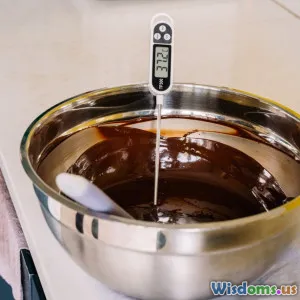
Five Reasons Your Cookies Turn Out Flat Every Time
9 min read Discover the five key reasons your cookies bake flat and learn expert tips to create perfectly risen, delicious cookies every time. (0 Reviews)
Five Reasons Your Cookies Turn Out Flat Every Time
Nothing is quite as disappointing as pulling a tray of cookies from the oven, only to find them flat, greasy, and disappointing. If you’ve measured carefully, followed the recipe, and still ended up with cookies that spread like pancakes, you’re not alone. Flat cookies can happen to bakers of all skill levels but understanding the underlying reasons is a game-changer.
In this article, we dive deep into the top five reasons your cookies turn out flat every time and share actionable strategies to help your cookies rise to perfection. Whether you’re aiming for chewy chocolate chip cookies or soft sugar cookies, these insights will elevate your baking.
1. Using Too Much Butter or Incorrect Butter Temperature
The Issue: Butter is a crucial ingredient that impacts flavor, texture, and structure. However, too much butter or butter that’s too warm can cause excessive spreading leading to flat cookies.
Butter melts at a relatively low temperature. When the butter in your dough is too soft or melted, the dough begins to spread faster than it can set in the oven’s heat. This effect turns cookies into thin discs rather than soft mounds.
What the Experts Say
According to food scientist Shirley Corriher, “Butter contributes to lowering the melting point, so soft butter releases fat rapidly and can cause dough to spread.”
How to Fix It
- Measure butter accurately—too much butter throws off the fat-to-flour ratio.
- Use butter just softened, not melted—press it gently with fingers; it should yield slightly but still hold shape.
- If your kitchen is warm, chill the dough before baking to firm the fat.
Example
If your cookie recipe calls for 1 cup of butter, ensure you use a solid, softened cup, not a melted equivalent. Refrigerating dough 30 minutes can also temper warm butter.
2. Insufficient Flour or Incorrect Flour Measurement
The Issue: Flour provides the bulk and structure your cookie dough needs to stand up and hold its shape. Using too little flour results in thin, flat cookies that spread out too much.
Bakers often underestimate flour volume, especially when using measuring cups improperly. Scooping flour bluntly with a dry cup can compress it, adding too much flour; using a spoon to fill or weighing flour ensures accuracy.
Real-World Insight
King Arthur Baking Company notes: “Too little flour and cookies will flatten. Too much flour and they’ll be dry and heavy.” Balance is key.
How to Fix It
- Weigh your flour for accuracy if possible (1 cup of all-purpose flour = 120 grams).
- Use the spoon-and-level method if weighing is not an option: spoon flour gently into measuring cup and level off with a flat edge.
- Follow the recipe flour quantities closely unless you know the flour type and humidity are affecting results.
Example
A classic Toll House cookie recipe yields perfectly chewy cookies because the flour amount was optimized to kin with the butter and sugar levels. Altering this by reducing a quarter cup can cause noticeable flattening.
3. Not Using Enough Leavening Agents or Using Expired Leaveners
The Issue: Baking soda and baking powder create the bubbles and lift cookies need to rise. Insufficient or expired leaveners will leave cookies dense and flat.
Many home bakers overlook the age of these chemical agents. Baking powder typically has a shelf life of 6 months to a year, and baking soda can lose potency as well.
How to Test Leaveners
- Baking Soda: Place a teaspoon in vinegar; if it bubbles vigorously, it’s active.
- Baking Powder: Mix a teaspoon with hot water—bubbling shows activity.
How to Fix It
- Always check leavener freshness and replace when inactive.
- Use correct measurements; too little doesn’t lift, too much can cause off-flavors and collapse later.
- Understand your recipe’s needs: chocolate cookies may require more soda to neutralize acidity.
Example
A cookie batch made with baking powder past its use-by date will not rise, resulting in brittle, flat cookies. Replacing the leavener improved rise and tenderness significantly.
4. Overmixing or Undermixing the Dough
The Issue: Mixing technique profoundly affects gluten development and incorporating air.
- Overmixing flour after adding it can develop too much gluten, causing tough, misshapen cookies that deflate.
- Undermixing leaves uneven dough, causing irregular spreading.
Scientific Insight
Gluten is a network of proteins that develops when flour and water mix. Balanced gluten development provides enough structure for the cookie to hold shape without being rigid.
How to Fix It
- Mix wet and dry ingredients separately, then combine until just mixed—stop when you see no flour streaks.
- Avoid beating dough aggressively after adding flour.
- For recipes needing air incorporation (creaming butter and sugar), mix until fluffy before flour addition.
Example
A baker switched from using a hand mixer on high speed to folding flour in gently with a spatula. The result was thicker cookies with less spread.
5. Baking Temperature and Oven Issues
The Issue: Oven temperature is crucial. Too low and cookies spread before setting; too high and they cook unevenly.
Home ovens can vary by 25 degrees or more from the set temperature, causing unpredictability.
Oven Realities
A study by America’s Test Kitchen found that many ovens are inaccurate, sometimes by up to 50°F. High temp helps cookies set quickly and retain shape.
How to Fix It
- Use an oven thermometer to calibrate your actual baking temperature.
- Preheat your oven thoroughly before baking.
- Bake cookie sheets one at a time in the center rack to promote even heat.
Example
Adjusting temperature from 325°F to 350°F made the difference between flat, greasy cookies and perfectly risen ones with a crisp edge and soft center.
Conclusion
Flat cookies can result from a mishmash of issues, but by systematically addressing butter temperature, flour measurement, leavening freshness, mixing methods, and oven temperature, you’ll gain control over the outcome. Baking is both art and science—fine-tuning these elements will result in perfectly shaped, flavor-packed cookies.
Try small adjustments one factor at a time. Document changes and watch your baking transform. Soon, you’ll turn flat cookie failures into bakery-worthy sweet treats that impress every time.
Rate the Post
User Reviews
Other posts in Baking & Pastry
Popular Posts















